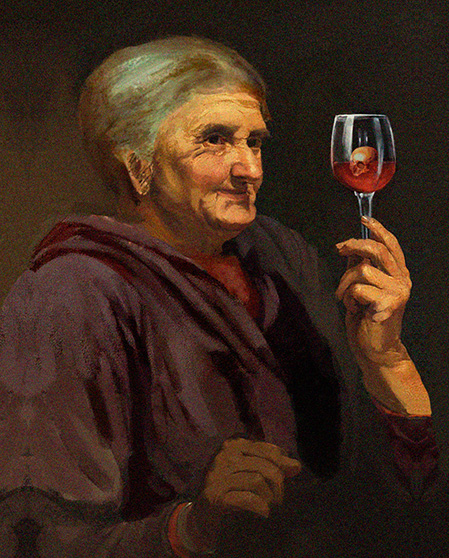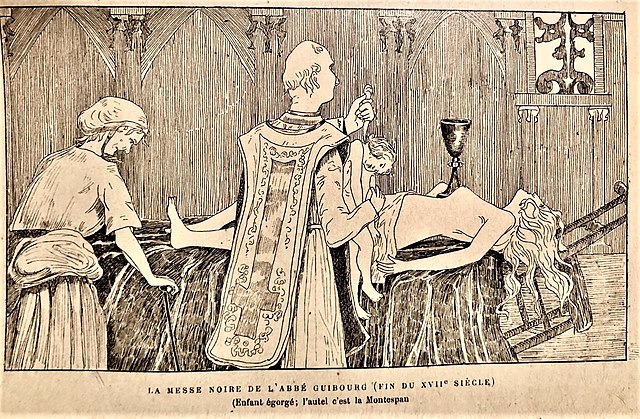La Voisin

Catherine Monvoisin, or Montvoisin, née Deshayes, known as La Voisin (c. 1640 – 22 February 1680), was a French fortune teller, commissioned poisoner, and professional provider of alleged sorcery.
She was the head of a network of fortune tellers in Paris providing poison, aphrodisiacs, abortion, magical services and the arranging of Black Masses, with clients among the aristocracy, and became the central figure in the famous affaire des poisons. Her purported organization of commissioned black magic and poison murder was suspected to have killed 1,000 people, but it is believed that upwards of 2,500 people might have been murdered.
La Voisin was interested in science and alchemy and financed several private projects and enterprises, some of them concocted by con artists who tried to swindle her.
Early life
Little is known of Catherine Deshayes' early life. She learned fortune telling as a child and later married Antoine Monvoisin, who was active as a jeweller and silk merchant with a shop at Pont-Marie in Paris.
Career as a fortune teller
When her husband's trade business led to bankruptcy, La Voisin supported the family by practising chiromancy and face-reading. In addition to being a fortune teller, she was also active as a midwife, which developed into providing abortions. Her business as a fortune teller gradually developed into manufacturing and selling purported magical objects and potions, arranging Black Masses and selling aphrodisiacs and poison to profit from her clients' wishes upon their future.
She developed her art by studying the modern methods of physiology, and the art of reading the client's future by studying their face and hands. She spent a great deal of money in order to provide an atmosphere which would make her clients more inclined to believe her prophecies: for example, she had a special robe of crimson red velvet embroidered with eagles in gold made for a price of 1,500 livres to perform in.
From the late 1660s, La Voisin had become a wealthy and famous fortune teller with clients among the highest aristocracy of France. She resided at Villeneuve-sur-Gravois, where she received her clients all day, and entertained the Parisian upper class society at parties with violin music in her garden at night.
In 1665 or 1666, her divination was questioned by the Congregation of the Mission at the Saint Vincent de Paul's order and she was called for questioning, but La Voisin defended herself successfully before the professors at Sorbonne University and was allowed to continue her business as a fortune teller.
Love charms
Her business as a fortune teller gradually developed into a business of professional black magic. During her activity as a fortune teller, she noticed similarities among her clients' wishes about their future: almost all wanted to have someone fall in love with them, that someone would die so that they might inherit, or that their spouses would die so that they might marry someone else.
La Voisin decided to profit financially from her clients' wishes by offering magic services to make their wishes come true. Initially, she told her clients that their wish would come true if it was also the will of God. Later, she started to recommend to her clients some action that would make their dreams come true. These actions were initially to visit the church of some particular saint; then she started to sell amulets, and gradually, she recommended more and more alleged magical objects or rituals of various kinds.
For those clients who wished for someone to fall in love with them, she manufactured love powders: the bones of toads, the teeth of moles, Spanish fly, iron filings, human blood and mummy, and the dust of human remains were among the alleged ingredients of the love powders concocted by La Voisin.
Black Masses
Finally, her most radical and expensive recommended practices were the Black Mass, which she arranged for clients for profit, during which the client could pray to Satan, and other demons, for their wish to come true. During some of these masses, a naked woman performed as an altar, upon which a bowl was placed: a baby was held above the bowl, and the blood from it was poured into the bowl. Whether the baby in question was actually killed on this occasion, or whether the baby was already dead by natural causes, such as being stillborn, could vary. These rituals typically included sex magic.
She had several associates working for her arranging and participating in her professional magic services, notably Adam Lesage, who performed alleged magical tasks; and the priest Étienne Guibourg and abbé Mariotte, who officiated at the Black Masses.
Poisoner
La Voisin took the step from creating magical potions, amulets, and rituals, to selling aphrodisiacs to those who wished for someone to fall in love with them, and fatal poison was given to those who wished for someone to die. The art of poisoning had become a regular science at the time, having been perfected, in part, by Giulia Tofana, a professional female poisoner in Italy, only a few decades before La Voisin. La Voisin provided a large variety of poisons for her clients and had a network of poison providers working for her, notably the apothecary Catherine Trianon.
On 12 March 1679, La Voisin was arrested outside Notre-Dame de Bonne-Nouvelle after having heard mass, just before her meeting with Catherine Trianon. In April 1679, a commission appointed to inquire into the subject and to prosecute the offenders met for the first time.
Aware of her alcoholism, however, her interrogators reportedly did not limit her access to alcohol but instead kept her in a state of drunkenness during her interrogations. In March, however, she named Marguerite Leféron and Francoise de Dreux as clients, and on 10 October, she admitted having sold poison and magical services to several members of the royal court; she also described the development of her career.
She also denied claims of using her oven to burn the bones of aborted infants that were too large for the grave area in her garden. She also counterclaimed any usage of poisons and that she only possessed purgatives for personal use or for her family. Another accusation she denied includes injecting syringes with fatal liquids into the bodies of pregnant women to "empty" them, after which the aborted foetuses were subsequently buried in the same manner at the garden grave.
Execution
On 17 February 1680, La Voisin was put on trial, and was convicted of witchcraft and sentenced to execution by burning two days later. In the days following her verdict until her execution, she was formally interrogated under torture, and the official document stated that she was tortured enough to beg for mercy.
La Voisin was executed in public on the Place de Grève in Paris on 22 February 1680. On her way to her execution, she reportedly pushed away the priest, and when fastened on the stake, she desperately pushed away the hay which was piled up around her.
Personal life
La Voisin regularly attended service at the church of the Jansenist abbé de Sant-Amour, principal of the Paris University, and the godmother of her daughter was the noblewoman Mme de la Roche-Guyon.
She supported a family of six, including her husband, her mother and her children. She was known to have at least six lovers: the executioner Andre Guillaume, Monsieur Latour, vicomte de Cousserans, the count de Labatie, the alchemist Blessis, the architect Fauchet, and the magician Adam Lesage. At one point, Adam Lesage tried to induce her to kill her husband, but while he was initially successful, she changed her mind and aborted the process.
She was known to suffer from alcoholism, was apparently abused by Latour, and engaged in several conflicts with her rival, the poisoner Marie Bosse.
